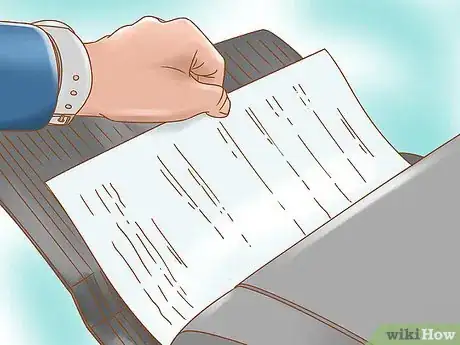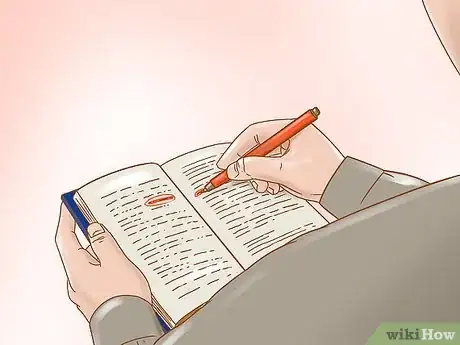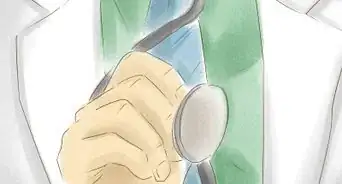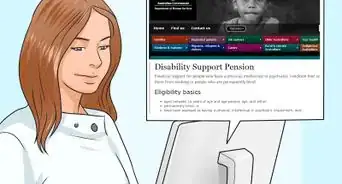This article was co-authored by Clinton M. Sandvick, JD, PhD. Clinton M. Sandvick worked as a civil litigator in California for over 7 years. He received his JD from the University of Wisconsin-Madison in 1998 and his PhD in American History from the University of Oregon in 2013.
There are 8 references cited in this article, which can be found at the bottom of the page.
This article has been viewed 76,813 times.
Sort-term disability benefits are offered by private insurers. As of 2015, there is no federal short-term disability program. Some employers may offer temporary disability as a benefit, and in a few states employers are required to provide this benefit. In order to apply, you need to submit an application to your employer or to the insurance carrier directly. Then, when the need arises, you file a claim.
Steps
Applying for Private Temporary Benefits
-
1Identify a provider. You may be able to get short-term disability benefits through your employer or union, who insure the private plan. If so, then the premiums can be deducted from your paycheck. If your employer or union does not offer short-term disability benefits, then you can purchase short-term disability on the marketplace.
- To find a private plan that works for you, search the Internet for “short-term disability private insurer.” You can then contact a carrier who will connect you with a licensed insurance agent.
- Compare different plans based on how high the premium is and what percentage of your base earnings will be replaced. You also want to look at how long the waiting period is before you can get benefits. For some plans, you need to wait a month or more.[1]
- Some plans also require that you take all of your sick leave before you can apply for temporary disability benefits.[2] If you do not have much sick time saved—or if you do not want to use it for a disability—then you might want to check out other plans.
-
2Get an application form. Contact Human Resources (HR) or your union to get a form to sign-up for short-term disability insurance. Alternately, your insurance agent will provide you with an application.Advertisement
-
3Pay premiums. Premiums can be deducted from your paycheck if your employer sponsors the disability plan. Otherwise, you will be responsible for making timely payments. If you miss a payment, your insurance may be suspended.
-
4File a claim when necessary. Contact HR or the insurance company and inform them that you need to file a claim. You should be given a form. You should provide all requested information, typing the information or printing neatly in black ink. Some information may need to be filled out by your employer.[3] You should work with them to get the necessary information, such as your earnings and employment status.
- Your doctor (or whoever has attended to you) will probably also need to complete information.[4] The physician may also need to complete a separate Physician’s Statement.[5]
- You will need to report the date of your illness and when you first were unable to work. You must also report the hospitals, clinics, or physicians who have treated you and what you believe is wrong with you.[6]
-
5Submit the form. Make a copy of the form and return it to the address provided.[7] If you are mailing the form to a private insurance carrier, you should send it certified mail, return receipt requested. This way, you will know when it is received.
- Wait to hear from the insurer. If you do not hear back in a couple of weeks, then contact your insurance agent or contact the carrier directly.
Applying for State Temporary Benefits
-
1Check if your state offers benefits. Currently, only a few states require short-term disability benefits: California, New York, New Jersey, Rhode Island, and Hawaii. The benefits differ depending on the state. In Hawaii, for example, employees can get up to 26 weeks of temporary disability benefits. In California, workers can get up to a year in benefits.[8]
- The amount of the benefit differs by state. In California, benefits are 55% of the wages the employee earned in the year before applying for benefits. New York employees can receive 50% of their average wage (up to a cap).
- Some of these states mandate that employers purchase private short-term disability for their employees from a private insurer. Do not be surprised if you have to file a claim with a private insurer.
-
2See if you qualify. Each state also has different qualifying criteria. You must meet the criteria in order to qualify. To find your state’s requirements, you should check with your Department of Labor.
- In Hawaii, for example, employees must have worked at least 20 hours a week for a minimum of 14 weeks. They also must have been paid at least $400 in wages per week.[9]
-
3Notify your employer that you are disabled. You should tell your employer that you need to apply for short-term disability benefits. Your employer should then provide you with the appropriate form to complete.[10]
- You will probably need the help of your doctor and employer to complete the form. You should give yourself plenty of time to get all of the necessary information in order to submit the claim in a timely manner.
-
4File a claim. After you have completed the application form, you should make a copy for your records and then mail the completed form to the appropriate office. The appropriate office may be your employer or the employer’s insurance carrier. In some states, you must return to the form to the state Department of Labor.[11]
-
5Provide follow-up information. You may be contacted to provide additional information. You should respond as soon as possible so that there is no delay in processing your claim.
- Otherwise, a determination should be quickly, depending on your state. In Hawaii, determinations are made within 90 days.[14] Check with your state’s Department of Labor.
References
- ↑ https://mn.db101.org/mn/programs/income_support/std_ltd/program2c.htm
- ↑ https://mn.db101.org/mn/programs/income_support/std_ltd/program2c.htm
- ↑ http://www.cigna.com/assets/docs/privacy-notices-and-forms/short_term_disability_benefits.pdf?WT.z_nav=member-forms%2Fsubmit-a-life-and-accident-claim-fraud-warning%2Fsubmit-a-life-accident-or-waiver-claim%2Fhow-to-file-a-disability-claim%3BBody%3BShort-term%20disability%20claim%20form
- ↑ http://www.cigna.com/assets/docs/privacy-notices-and-forms/short_term_disability_benefits.pdf?WT.z_nav=member-forms%2Fsubmit-a-life-and-accident-claim-fraud-warning%2Fsubmit-a-life-accident-or-waiver-claim%2Fhow-to-file-a-disability-claim%3BBody%3BShort-term%20disability%20claim%20form
- ↑ http://www.cigna.com/assets/docs/privacy-notices-and-forms/physician_statement.pdf?WT.z_nav=member-forms%2Fsubmit-a-life-and-accident-claim-fraud-warning%2Fsubmit-a-life-accident-or-waiver-claim%2Fhow-to-file-a-disability-claim%3BBody%3BPhysician's%20Statement
- ↑ http://www.cigna.com/assets/docs/privacy-notices-and-forms/short_term_disability_benefits.pdf?WT.z_nav=member-forms%2Fsubmit-a-life-and-accident-claim-fraud-warning%2Fsubmit-a-life-accident-or-waiver-claim%2Fhow-to-file-a-disability-claim%3BBody%3BShort-term%20disability%20claim%20form
- ↑ http://www.cigna.com/assets/docs/privacy-notices-and-forms/short_term_disability_benefits.pdf?WT.z_nav=member-forms%2Fsubmit-a-life-and-accident-claim-fraud-warning%2Fsubmit-a-life-accident-or-waiver-claim%2Fhow-to-file-a-disability-claim%3BBody%3BShort-term%20disability%20claim%20form
- ↑ http://www.disabilitysecrets.com/resources/disability/short-term-disability-laws/short-term-disabili
- ↑ http://www.disabilitysecrets.com/resources/disability/short-term-disability-laws/short-term-disabili
- ↑ http://labor.hawaii.gov/dcd/home/about-tdi/
- ↑ http://www.nolo.com/legal-encyclopedia/new-jersey-temporary-disability-benefits-tdi.html
- ↑ http://www.nolo.com/legal-encyclopedia/new-jersey-temporary-disability-benefits-tdi.html
- ↑ http://www.nolo.com/legal-encyclopedia/california-short-term-disability-benefits.html
- ↑ http://labor.hawaii.gov/dcd/home/about-tdi/
About This Article
If you need to apply for short term disability benefits through a private provider, check to see if your employer or union offer any plans before finding a carrier on the marketplace. When you look for a provider, check to see what eligibility requirements are needed for each plan, as some might require you to use all of your sick leave before applying. Once you’ve found a plan, fill out the application and pay any premiums. Make sure to contact your employer’s human resources department or the insurance and tell them you need to file a claim. Then, they will provide you with a form to fill out with your employer, which you’ll need to send through certified mail. For more help from our Legal co-author, including how to apply for temporary benefits through your state, scroll down.




































































